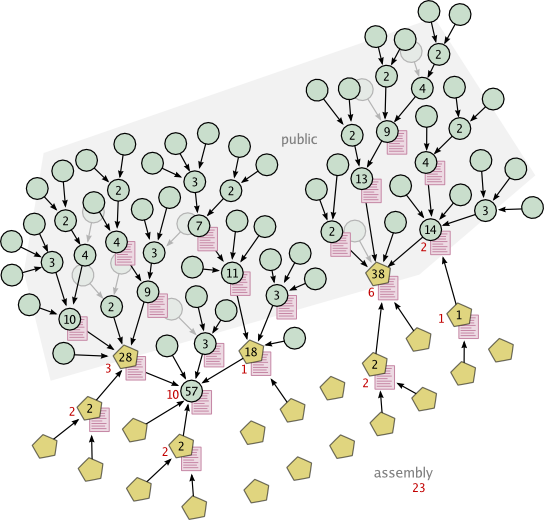User:Test-62-ZeleaCom/G/p/vohall/sketch

Votorola is social software in support of public autonomy through communicative action. We develop the tools to enable a radically free, self-determined society in which plans of action are coordinated by discussion aimed at mutual understanding and consensus.1
| Project | Mailing list, Chat, Contributors |
|---|---|
| Software | Licence, Changes, Download, Manual |
| Source | Files, Repository, Java API, Build instructions |
| Practice | Pose an issue, Grow the discussion, Act on it |
1. Raise an issue
Think of a social problem or goal that is inexplicably difficult to solve or achieve; one of those unfortunate situations that has people shaking their heads and asking, "Why did they never get a handle on that?" Write down a possible solution in a form that is actionable. Actionable forms include plans ("first we do this, then we do that"), policies ("one should always do this, one should never do that") and laws ("nobody shall do this, it is forbidden"). But keep it short, just a sentence or two.
FIG. Sketching a solution. - thought bubble of problem or goal - written solution in cursive script
Describe in detail what is depicted in the following figure.
 |
2. Grow the discussion
Grow the discussion while simultaneously building up the resources necessary for action, especially the resource of agreement. Make use of the following practices.
Planting | Pipe laying
Here a summary transcluded from those practice pages. Describe in detail what is depicted in the following figure.
FIG. Planting a discussion. - minimal tree - 3 users in group - one introduces group to forum
Legitimation
Here a summary transcluded from that practice page. Describe in detail what is depicted in the following figure.
FIG. Eliciting critique.
- 3 users in group
- proposal comes from a user
- "Is this valid, do you think? Can you see anything wrong with it?"
- critical points of public formalized, copied into patch record
- informal participant => circle with fill only
Describe in detail what is depicted in the following figure.
FIG. Formal proposal.
- one of the critical points (#%&) thought of
by informal person (#%&!) and user (#%&?)
- proposal comes from pipe
Describe in detail what is depicted in the following figure.
FIG. Decision against.
g.
- "reason" (#%&) goes into proposal record
g.
- user announces "Rejected for reason #%&"
- informal critic joins group to help
Describe in detail what is depicted in the following figure.
FIG. Decision for.
g.
- acceptance
g.
- user (or ghost of) announces "Accepted"
- application, e.g. text flow
- 2 users move to one new variant
- 1 user + informal person (now user) move to another
Describe in detail what is depicted in the following figure.
FIG. Self-sustained reproduction.
- top: forum and critical points
- cyclic arrow
- up and into top (carrying talk bubbles)
- has the actionable structure to motivate discussion
- out (carrying formal users) and down to middle
- middle: outline of small tree, with tiny green users
- bottom: time series (downward) of larger tree, then forest
Patch relaying
Here a summary transcluded from that practice page. Describe in detail what is depicted in the following figure.
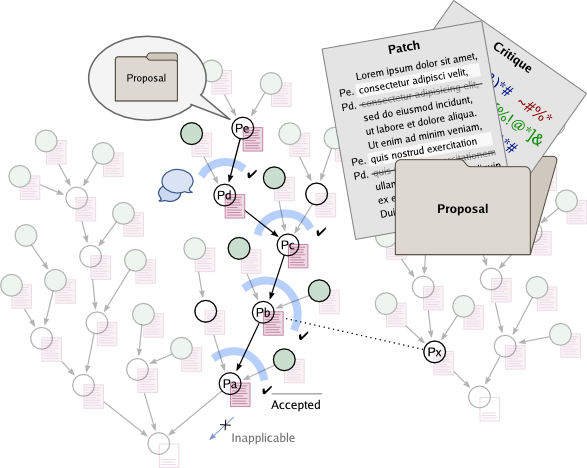 |
Describe in detail what is depicted in the following figure.
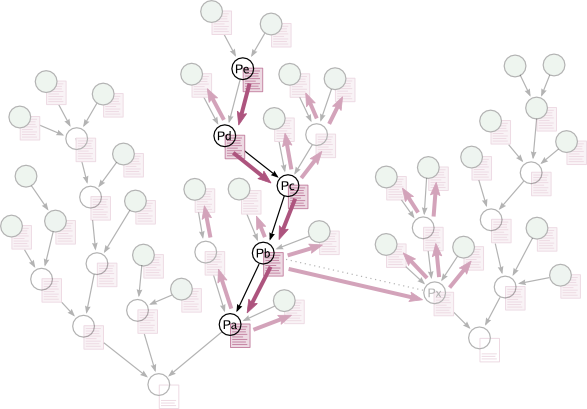 |
Position space rationalization | Composition | Variation | Abstraction
Here a summary transcluded from those practice pages. Describe in detail what is depicted in the following figure.
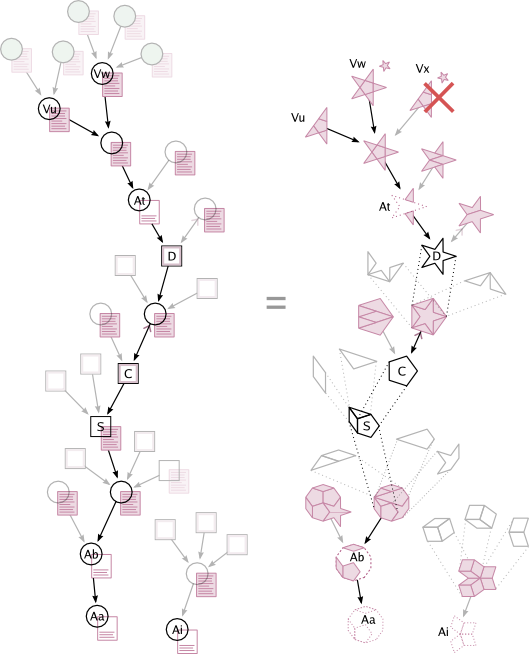 |
Branch shifting | Consensus bridging
Here a summary transcluded from those practice pages. Describe in detail what is depicted in the following figure.
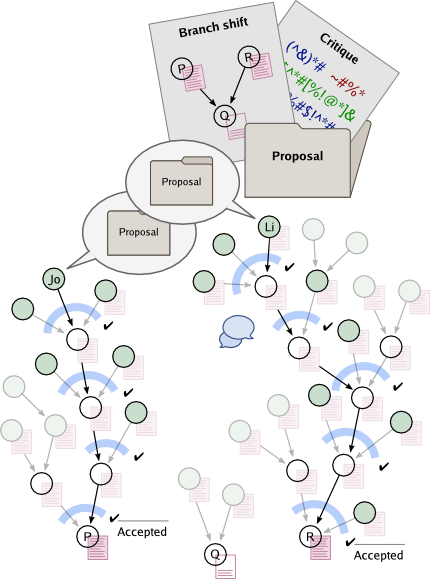 |
Describe in detail what is depicted in the following figure.
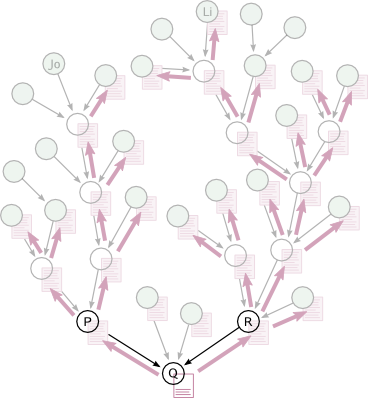 |
Free flying
Here a summary transcluded from that practice page. Describe in detail what is depicted in the following figure.1
Describe in detail what is depicted in the following figure.
FIG. Bidirectional arc pointing left and right (free motion) over a forest of three trees. Inside are pipe positions (bare branches), outside are personal positions, voter stakes and informal participants (leaves). Multi-coloured discussion arcs show a patchwork of forums, each centered on a candidate node.
Describe in detail what is depicted in the following figure.
FIG. Same top arc and forest, but now showing stacks of up to three drafts for each pipe position, each draft a different colour (language). Depth of stack decreases toward leaves, and most of the periphery is unilingual, exhibiting different colours here and there.
Describe in detail what is depicted in the following figure.
FIG. Same top arc and forest, but now showing three different colours of arrow/node (different voting tools) randomly distributed throughout the forest.
3. Act on it
Resolve the issue by redeeming the resource pledges in a combination of immediate, administrative, legislative and/or electoral action.
Immediate action
Describe in detail what is depicted in the following figure.
FIG. Forest above with magnifier callout on one of the drafts showing the stylized content of a plan with a manhour estimate and a division into three workgroups (dots separated by bars). Flow of hour pledges is shown in forest instead of votes. Below the three workgroups are assembled together with an arrow "Action" pointed down.
Administrative action
Describe in detail what is depicted in the following figure.
FIG. Forest above with magnifier callout on one of the drafts showing the stylized content of a plan. Below the hierarchy of an administration together with an arrow "Action" pointed down.
Legislative action
Describe in detail what is depicted in the following figure.
FIG. Forest above and assembly voting below, as in figure of legislative action on current home page. But add a magnifier callout on one of the drafts to show the stylized content of a legislative bill.
Electoral action
Describe in detail what is depicted in the following figure, viz. a plurality election (e.g. Anglo-French) to an assembly seat.
FIG. Split top and bottom. Top shows forest above a ballot, and arrow labeled "Nomination" extending from root candidate of largest tree to name on ballot. Bottom shows same tree with assembly below. All votes in tree are collapsed directly onto root candidate (no delegates) who sits on ballot. Arrow labeled "Election" extends from root candidate to a single assembly seat (Anglo-French plurality election).
Describe in detail what is depicted in the following figure, viz. a proportional election (e.g. continental Europe) by way of public parties.
FIG. Split top and bottom. Top shows forest above three party lists, each a different colour (different party). Nodes are likewise different colours (different voting facilities). Arrows labeled "Nomination" extend from root candidates to names on the first list, all ordered by popularity. The other two lists have identical names. Bottom shows same tree with assembly below. All votes in tree are collapsed directly onto party list whose colour matches that of the node. Arrows labeled "Election" extend from the first two names on the first list to two assembly seats, and the same names are crossed off the others lists. A third arrow extends from the third name on the second list to a third assembly seat.
Describe in detail what is depicted in the following figure, viz. an election to executive office.
FIG. Split top and bottom. Top shows forest with magnifier callout on one draft showing an administrative hierarchy. Arrow labeled "Nomination" extends from root candidate of largest tree to name on ballot below. Bottom shows same tree above the administrative hierarchy. All votes in tree are collapsed directly onto root candidate (no delegates) who sits on ballot. Arrow labeled "Election" extends from root candidate to top of hierarchy, while arrow labeled "Appointment" points downward alongside hierarchy.
Notes
- ^ a b We open a realm of unrestricted, universal and equal freedom of opinion, expression and association (top). We join it to the production of binding norms and facts (bottom) through the mediation of procedures designed to encourage what Habermas describes as a "discursive process of opinion- and will-formation, in which the illocutionary binding forces of a use of language oriented to mutual understanding serve to bring reason and will together—and lead to convincing positions to which all individuals can agree without coercion".2
FIG. Bidirectional arrow over two trees, labeled above "Realm of freedom". Below trees labeled "Realm of force".This is communicative action at societal scales. In contemporary discourse theory, communicative action is simultaneously the source of legitimacy for modern law, and the key to the relation between private and public freedoms, between human rights and democracy.
However, if discourses (and, as we will see, bargaining processes as well, whose procedures are discursively grounded) are the site where a rational will can take shape, then the legitimacy of law ultimately depends on a communicative arrangement: as participants in rational discourses, consociates under law must be able to examine whether a contested norm meets with, or could meet with, the agreement of all those possibly affected. Consequently, the sought for internal relation between popular sovereignty and human rights consists in the fact that the system of rights states precisely the conditions under which the forms of communication necessary for the genesis of legitimate law can be legally institutionalized. The system of rights can be reduced neither to a moral reading of human rights nor to an ethical reading of popular sovereignty, because the private autonomy of citizens must neither be set above, nor made subordinate to, their political autonomy. The normative intuitions we associate conjointly with human rights and popular sovereignty achieve their full effect in the system of rights only if we assume that the universal right to equal liberties may neither be imposed as a moral right that merely sets an external constraint on the sovereign legislator, nor be instrumentalized as a functional prerequisite for the legislator's aims. The co-originality of private and public autonomy first reveals itself when we decipher, in discourse-theoretic terms, the motif of self-legislation according to which the addressees of law are simultaneously the authors of their rights. The substance of human rights then resides in the formal conditions for the legal institutionalization of those discursive processes of opinion- and will-formation in which the sovereignty of the people assumes a binding character.3
While modern law is the medium through which complex societies are regulated, its legitimacy depends on external participation in public discourses that law itself cannot enforce. It can go no further than to open the door to private volition.
By securing both private and public autonomy in a balanced manner, the system of rights operationalizes the tension between facticity and validity, which we first encountered as a tension between the positivity and the legitimacy of law. Both moments combine in the mutual penetration of legal form and discourse principle, as well as in the Janus faces that law turns toward its addressees on the one side and its authors on the other. On the one side, by way of coercible laws that render equal liberties compatible, the system of rights unleashes the self-interested choice of individual subjects oriented by personal preferences. On the other side, in the practice of legislation, it mobilizes and unifies the communicative freedom of citizens presumptively oriented to the common good. Here the tension between facticity and validity flares up anew; indeed, it is concentrated in the seemingly paradoxical circumstance that basic political rights must institutionalize the public use of communicative freedom in the form of individual rights. The legal code leaves no other alternative; communicative and participatory rights must be formulated in a language that leaves it up to autonomous legal subjects whether, and if necessary how, they want to make use of such rights. It is left to the addressees' free choice: whether or not they want to engage their free will as authors, shift their perspective from their own interests and success to mutual understanding over norms acceptable to all, and make public use of their communicative freedom.4
The connection between private and public autonomy is then brought home in the personal implications of a question such as, "Why did they never get a handle on that?"
- ^ Jürgen Habermas. 1992. Between facts and norms: contributions to a discourse theory of law and democracy. Translated by William Rehg, 1996. MIT Press, Cambridge, Massachusetts. p. 103.
- ^ ibid. p. 103-4
- ^ ibid. p. 129-30
